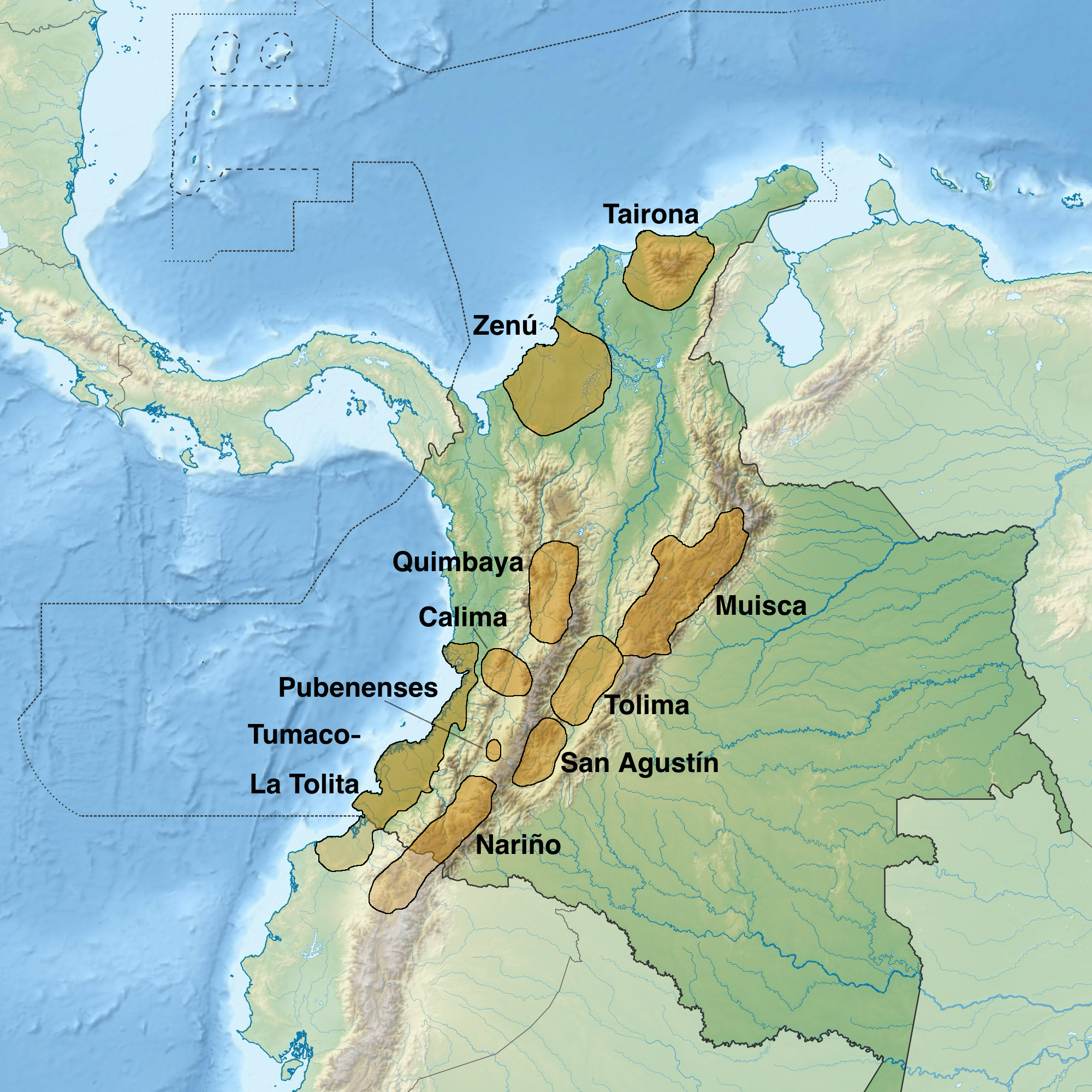|
Zenú
The ''Zenú'' or ''Sinú'' is a Pre-Columbian cultures of Colombia, pre-Columbian culture and Indigenous people in Colombia, whose ancestral territory comprises the valleys of the Sinú River, Sinú and San Jorge River, San Jorge rivers as well as the coast of the Caribbean around the Gulf of Morrosquillo. These lands lie within the departments of Córdoba Department, Córdoba and Sucre Department, Sucre. The Zenú civilization peaked from about 200 BCE to about 1600 CE, constructing major waterworks and producing gold ornaments. The gold that was often buried with their dead lured the Spanish conquistadors, who looted much of the gold. With the arrival of the Spaniards, the tribe almost died out due to excessive taxation, forced labor, and western diseases. The Zenú language disappeared around 200 years ago. However, the 2018 Colombian Census showed 307,091 Zenú people in Colombia. In 1773 the King of Spain designated 83,000 hectares in San Andrés de Sotavento as a Zenú Lan ... [...More Info...] [...Related Items...] OR: [Wikipedia] [Google] [Baidu] |
Sucre Department
Sucre () is a department in the Caribbean Region of Colombia. The department ranks 27th by area, and it has a population of 904,863, ranking 20th of all the 32 departments of Colombia. Sucre is bordered by the Caribbean on the northwest; by Bolívar Department on the east and by Córdoba Department on the west. Sucre was named in honor of the Independence hero Antonio José de Sucre who was quoted by the founders of this department in reference to Simón Bolívar's death as saying "They have killed my heart", expression said while cruising the territory of the present day Sucre Department. As of 2009, the Sucre Department has an estimated population of 802,733, of which 234,886 are in the department capital Sincelejo, according to the DANE projections. History Pre-Columbian Before the Spanish Conquest, the land comprising the department of Sucre was mainly inhabited by two groups of indigenous people — the Zenú and the Turbacos. The Zenú language was perhaps part ... [...More Info...] [...Related Items...] OR: [Wikipedia] [Google] [Baidu] |
Sinúfana Language
Sinúfana (Cenufana; also Cenu/Zenu/Sinú) or Guajibo (Guamacó) is a poorly attested, and possibly Chocoan language of Colombia Colombia, officially the Republic of Colombia, is a country primarily located in South America with Insular region of Colombia, insular regions in North America. The Colombian mainland is bordered by the Caribbean Sea to the north, Venezuel ..., with very few speakers. References Choco languages Languages of Colombia Extinct languages of South America Unclassified languages of South America {{na-lang-stub ... [...More Info...] [...Related Items...] OR: [Wikipedia] [Google] [Baidu] |
Pre-Columbian Cultures Of Colombia
The pre-Columbian cultures of Colombia refers to the ancient cultures and civilizations of Colombia. Population The population of pre-Columbian cultures in the modern-day country of Colombia is estimated to have been around 6 million. Around a third of them, or about 2 million people were Muiscas located in Andean highlands, with the population being concentrated in a similar way to modern-day Colombia. Lower estimates number the pre-Columbian population at just around 3 million people whereas higher estimates place the population at 10-12 million people. Geography Owing to its location, the present territory of Colombia was a corridor of early human migration from Mesoamerica and the Caribbean to the Andes and Amazon basin. The oldest archaeological finds are from the Pubenza and El Totumo sites in the Magdalena Valley southwest of Bogotá. These sites date from the Paleoindian period (18,000–8000 BCE). At Puerto Hormiga and other sites, traces from the Archaic Perio ... [...More Info...] [...Related Items...] OR: [Wikipedia] [Google] [Baidu] |
San Jorge River
The San Jorge River is a river in Colombia that begins in National Park Paramillo (departments of Antioquia and Córdoba) and that runs between the mountains of San Geronimo and Ayapel before flowing into the River Cauca in Sucre Department. The drainage basin comprises in the southeast of Córdoba Department, including the waters of Ayapel swamp and the Mompox region via the Caribbean departments of Cordoba, Sucre and Bolivar. Its tributaries are the rivers San Pedro, Dirty and Ure. The river registers a minimum flow of and a maximum of . Currently the San Jorge is one of the rivers with fish wealth, but its high pollution and deterioration was due largely to fishing with explosives and obtaining gold alluvium of its waters by the method of flotation mercury. History The San Jorge was found by the Spanish conquistador Alonso de Heredia, while seeking to establish contact with the indigenous Zenú culture in the 1530s. At that time the river was known under the name ... [...More Info...] [...Related Items...] OR: [Wikipedia] [Google] [Baidu] |
Colombia
Colombia, officially the Republic of Colombia, is a country primarily located in South America with Insular region of Colombia, insular regions in North America. The Colombian mainland is bordered by the Caribbean Sea to the north, Venezuela to the east and northeast, Brazil to the southeast, Peru and Ecuador to the south and southwest, the Pacific Ocean to the west, and Panama to the northwest. Colombia is divided into 32 Departments of Colombia, departments. The Capital District of Bogotá is also the List of cities in Colombia by population, country's largest city hosting the main financial and cultural hub. Other major urban areas include Medellín, Cali, Barranquilla, Cartagena, Colombia, Cartagena, Santa Marta, Cúcuta, Ibagué, Villavicencio and Bucaramanga. It covers an area of 1,141,748 square kilometers (440,831 sq mi) and has a population of around 52 million. Its rich cultural heritage—including language, religion, cuisine, and art—reflects its history as a co ... [...More Info...] [...Related Items...] OR: [Wikipedia] [Google] [Baidu] |
Sinú - Olla With Annular Base And Modeled Figures - Walters 482860 - Side A
Sinú may refer to: * Sinú River, Colombia * The Zenú, also known as Sinú, peoples of Colombia * "Sinu" (Masterpiece song), a 2009 song by Malaysian band Masterpiece See also * * Sinew A tendon or sinew is a tough band of dense fibrous connective tissue that connects muscle to bone. It sends the mechanical forces of muscle contraction to the skeletal system, while withstanding tension. Tendons, like ligaments, are made of ..., a tough band of fibrous connective tissue that connects muscle to bone * Sinus (other) * Sino (other) * Seenu (other) {{Disambiguation ... [...More Info...] [...Related Items...] OR: [Wikipedia] [Google] [Baidu] |
Lost-wax Casting
Lost-wax castingalso called investment casting, precision casting, or ''cire perdue'' (; borrowed from French)is the process by which a duplicate sculpture (often a metal, such as silver, gold, brass, or bronze) is cast from an original sculpture. Intricate works can be achieved by this method. The oldest known examples of this technique are approximately 6,500 years old (4550–4450 BC) and attributed to gold artefacts found at Bulgaria's Varna Necropolis. A copper amulet from Mehrgarh, Indus Valley civilization, in present-day Pakistan, is dated to circa 4,000 BC. Cast copper objects, found in the Nahal Mishmar hoard in southern Israel, which belong to the Chalcolithic period (4500–3500 BC), are estimated, from carbon-14 dating, to date to circa 3500 BC. Other examples from somewhat later periods are from Mesopotamia in the third millennium BC. Lost-wax casting was widespread in Europe until the 18th century, when a piece-moulding process came to predominate. The step ... [...More Info...] [...Related Items...] OR: [Wikipedia] [Google] [Baidu] |
Ayapel
Ayapel is a town and municipality located in the Córdoba Department, northern Colombia Colombia, officially the Republic of Colombia, is a country primarily located in South America with Insular region of Colombia, insular regions in North America. The Colombian mainland is bordered by the Caribbean Sea to the north, Venezuel .... Ayapel is a Colombian municipality located in the far eastern department of Cordoba and bathed by the waters of San Jorge and Ayapel swamp. Bounded on the north by San Marcos, San Benito Abad, and Majagual, on the east by Guaranda and Achi, on the west by Buenavista and Montelibano, Pueblo Nuevo and south to the department of Antioquia. According to 2020 estimates, the population of Ayapel was 47,247. Climate References Gobernacion de Cordoba - AyapelAyapel official website {{coord, 8, 19, N, 75, 09, W, region:CO_type:city_source:GNS-enwiki, display=title Córdoba ... [...More Info...] [...Related Items...] OR: [Wikipedia] [Google] [Baidu] |
Gold Thread
Goldwork is the art of embroidery using metal threads. It is particularly prized for the way light plays on it. The term "goldwork" is used even when the threads are imitation gold, silver, or copper. The metal wires used to make the threads have never been entirely gold; they have always been gold-coated silver or cheaper metals, and even then the "gold" often contains a very low percent of real gold. Most metal threads are available in silver and sometimes copper as well as gold; some are available in colors as well. Goldwork is always surface embroidery and free embroidery. The vast majority is a form of laid work or couching; that is, the gold threads are held onto the surface of the fabric by a second thread, usually of fine silk. The ends of the thread, depending on type, are simply cut off, or are pulled through to the back of the embroidery and carefully secured with the couching thread. A tool called a ''mellore'' or a stilleto is used to help position the threads a ... [...More Info...] [...Related Items...] OR: [Wikipedia] [Google] [Baidu] |
Filigree
Filigree (also less commonly spelled ''filagree'', and formerly written ''filigrann'' or ''filigrene'') is a form of intricate metalwork used in jewellery and other small forms of metalwork. In jewellery, it is usually of gold and silver, made with tiny beads or twisted threads, or both in combination, soldered together or to the surface of an object of the same metal and arranged in artistic motifs. It often suggests lace and remains popular in Indian and other Asian metalwork. It was popular as well in Italian, French and Portuguese metalwork from 1660 to the late 19th century. It should not be confused with ajoure jewellery work, the ajoure technique consisting of drilling holes in objects made of sheet metal. The English word filigree is shortened from the earlier use of ''filigreen'' which derives from Latin meaning thread and grain, in the sense of small bead. The Latin words gave ''filigrana'' in Italian which itself became ''filigrane'' in 17th-century Frenc ... [...More Info...] [...Related Items...] OR: [Wikipedia] [Google] [Baidu] |



